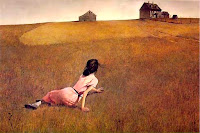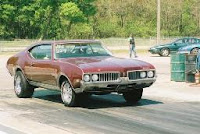I’ve told this story many times over the years and friends have suggested that I write it down for “posterity.” I am not sure if this blog can be considered as such, but I will tell the story anyway.
I can begin by telling you this idea was re-stimulated by
an article in today’s Maine Sunday Telegram (MST). The MST and the Portland Press Herald love to have “human interest” stories this time of year – I’m sure to appeal to “visitors from away.” Indeed there are always some great folksy articles and stories in the summer issues, and I always look forward to reading them.
Today’s featured article in the Audience (Arts) section is about Maine’s most famous living artist, Andrew Wyeth who spends his summers in the mid-coast area. His son Jamie, perhaps the second most famous living artist in Maine lives here almost year round. But the article is not so much about Andrew as it is about the whole clan, and particularly Victoria (known to all as Vic) , Andrew’s 28-year-old granddaughter who has become something of a family historian and commentator.
The article provides a delightful insight into some of the background of the family and includes some vignettes of some the family eccentricities including the detonation of “crazy” Aunt Carolyn ashes, and a recent birthday party for grandpa complete with Uncle Jamie lighting off cannons.
But that’s not my story, mine is better.
It begins in 1970 when I was a camp counselor at a camp located in the town of Cushing, Maine. Each Sunday, the camp co-director (aka “The Old Man”) would take a bunch of kids and me to Rockland to attend church. This trip was only for baptized and practicing “mackerel snappers” and required a special request from parents. Somehow I was selected to be the token staff person to attend with the campers as the camp’s co-director wasn’t of that religious persuasion.
One of the things I enjoyed about this weekly trip was the opportunity to get off the island where the camp was located and see a little bit more of Maine. One Sunday, we took some back roads on our return from church and The Old Man seemed to be hunting for something and we made our way south of Thomaston and on to the back roads of Cushing. At some point along the way he suddenly turned the van off the road and on to a dirt driveway that led down to an old weather-beaten house. A sign at the end of the driveway noted
“Olson House” and the ancient building overlooking a broad hayfield that provided a decent view of the St. George’s River beyond. The Old Man announced that this was the place where “that artist guy painted the picture of the crippled girl on the hill.” He fumbled for more details and then remembered the Wyeth name. For some strange reason, I could immediately visualize the picture he described. Strange because at the grand old age of 17, I certainly was not a connoisseur of American art and clearly had only rudimentary knowledge of Andrew Wyeth and
“Christina’s World.”
The visit was brief, we didn’t even get out of the van, and soon we were back on the road heading to camp.
The story may have ended here, but several weeks later, my father and sisters were in Maine to visit me at camp and I had my father take this same route to camp from Rockland. Remembering and relating the story about the old farm house, my father became very interested and insisted we see the spot. Somehow I found the driveway and soon learned that my father was a bit of a Wyeth fan and thought this part of the trip was a particularly special bonus.
This time I did get out of the car and looked around the house and the adjoining “out buildings;” a series of sheds and small building that appeared to have been used to keep farm animals. The house and property did not appear occupied at that time, but the ground otherwise looked cared for. The multitude of years of brutal Maine weather had left the outside of the buildings in pretty tough shape and it was obviously they had not been painted in many years.
At this point I was still a bit in the fog when it came to Christina’s World. My father had immediately recalled the name of the painting as I described what The Old Man had said. He even knew that Olson was the name of the woman depicted in the painting; Christina Olson lived here. But it was only what happened next that burned the image of Christina and her world into my permanent memory.
It occurred when I happened to look through the window of one of the out buildings. There, affixed to the wall with some simple thumb tacks were a series of sketches of the major elements of the Christina’s World painting. Initially perplexed, I quickly figured out that these must have been the
practice sketches Wyeth used to compose the final painting. Drawn in pencil and clearly damaged by rust stains that had bled out of the thumb tacks, the collection included sketches of the house and a few of Christina herself. None of the sketches contained all of the elements together and I realized had perhaps I had an insight into how an artist mind must work; dabbling along with disparate pieces before the whole gestalt is formed.
Being a bit of a typical teenager, I think I jokingly suggested that we break the window and take one or two of the sketches. It clearly appeared that these things had been here for ages and it was not likely anyone would miss them.
I’ve told the “sketches” story a number of times over the years - to anyone who expressed any interest in Wyeth – but most people acted as though this was all a bit of bullshit on my part. As time went on, and memories faded or became confused with other experiences, I too began to doubt my recall. When, as an adult I began to realize the value and power of this painting, I could not imagine that the artist would have left these sketches in a seemingly abandoned barn in Cushing, Maine. After all, Christina’s World was painted in 1948 which means the sketches would have to have been hanging there for over 20 years when I saw them in 1970. In subsequent trips to the Olson house, the sketches were no where to be found, adding to my doubt.
Sometime in the late 1990s
the Farnsworth Museum, opened The Wyeth Center, a former church converted into a special gallery for viewing and learning about Andrew Wyeth, his famous son Jamie and his equally famous father, N.C. Wyeth. Indeed it was at about this time Christina made her return to Maine and over the years the museum has held many special exhibits of Wyeth works.
A few years later, the museum held an exhibit of something extraordinary, something that made me drop everything a take a trip to Rockland. It was an exhibit of preliminary sketches of Christina’s World.
There in Rockland on a rainy weekday afternoon, I came face-to-face with the sketches I had seen hanging in the Olson’s barn nearly 30 years earlier. Meticulously restored, the sketches were now beautifully matted and framed. In the adjoining descriptions, I learned that they had indeed been left to hang in the Olson House as the artist had used that space up until 1969 to paint many other scenes in that locale.
So, it was all true. I did see them. And, now they were owned by a rich Japanese collector and worth millions of dollars.
I told my story, once again, to a docent working at the exhibit. She shuttered at the thought of my adolescent audacity to “help myself” to some of history’s most treasured artifacts. I had to reassure her several times I was only kidding, although I think the security guards might have been keeping an extra eye on me for the rest of my visit.
So, that’s my story and it’s nice to know that it happened the way I remember it. I have often thought of what it would be like to meet Andrew Wyeth and tell him my tale. I think from what I know about him, he’d get a kick out of it. Who knows, maybe he will read this and give me a call. Better yet, Vic will read the story and invite me over for a couple of beers.
More about Christina's World
UPDATE: July 5, 2010 - The Olsen House has been made a national landmark.
Here is a story from Boston.com. Currently,
The Farnsworth Museum has an exhibit of the "studies" described in my story. Check them out, you can see the rust marks. Finally, from reading the Boston.com story listed above, I learned that Andrew Wyeth is buried in Hathorn Cemetery located adjacent to the Olsen House.
See Find-a-Grave for map
~jeb





